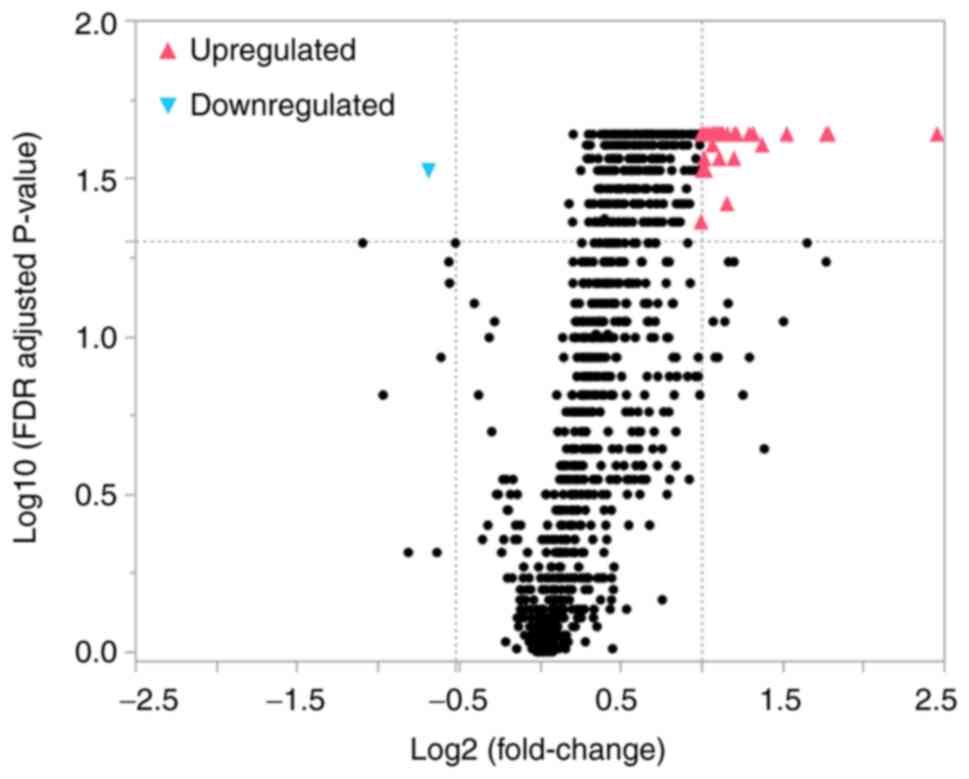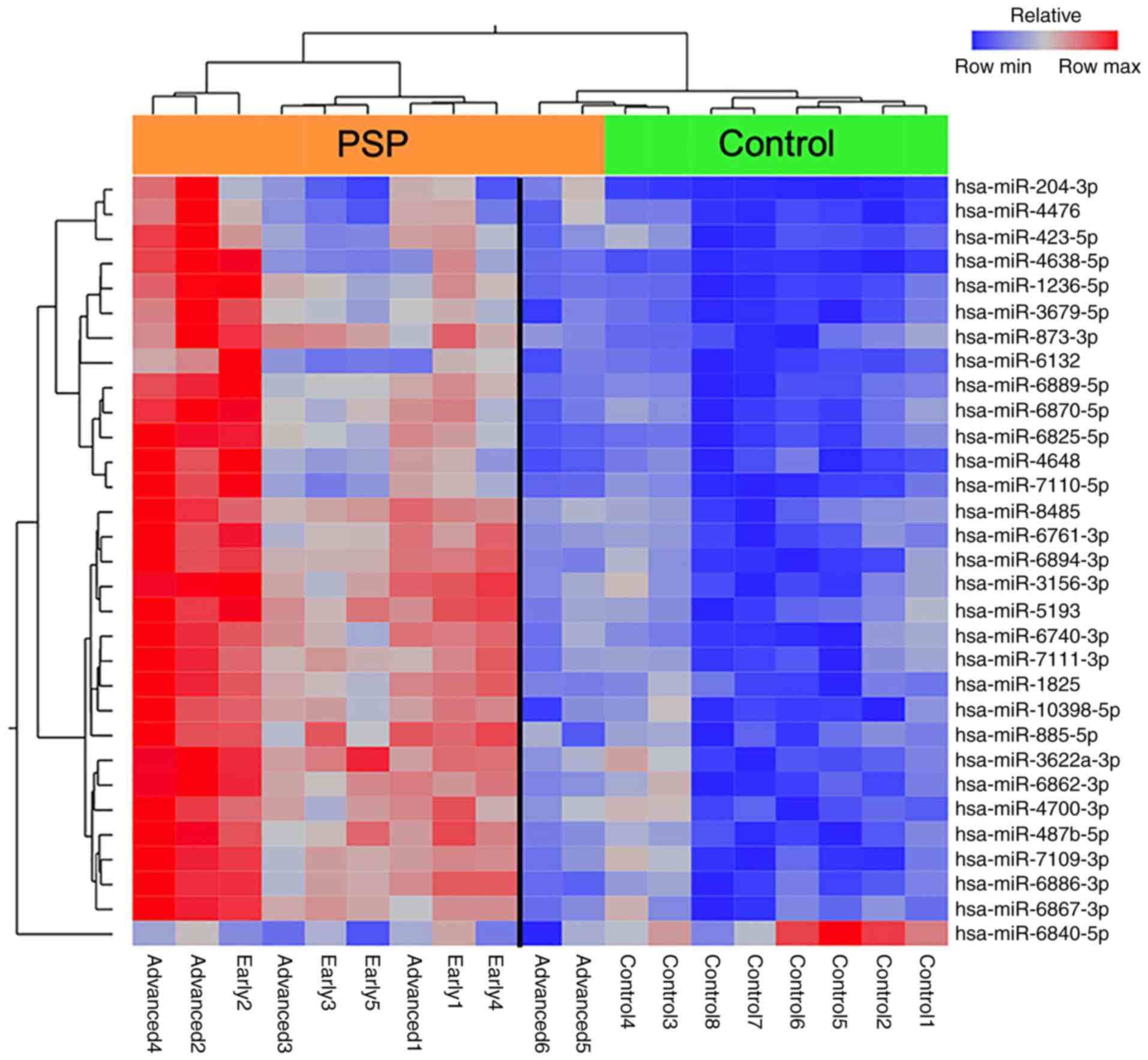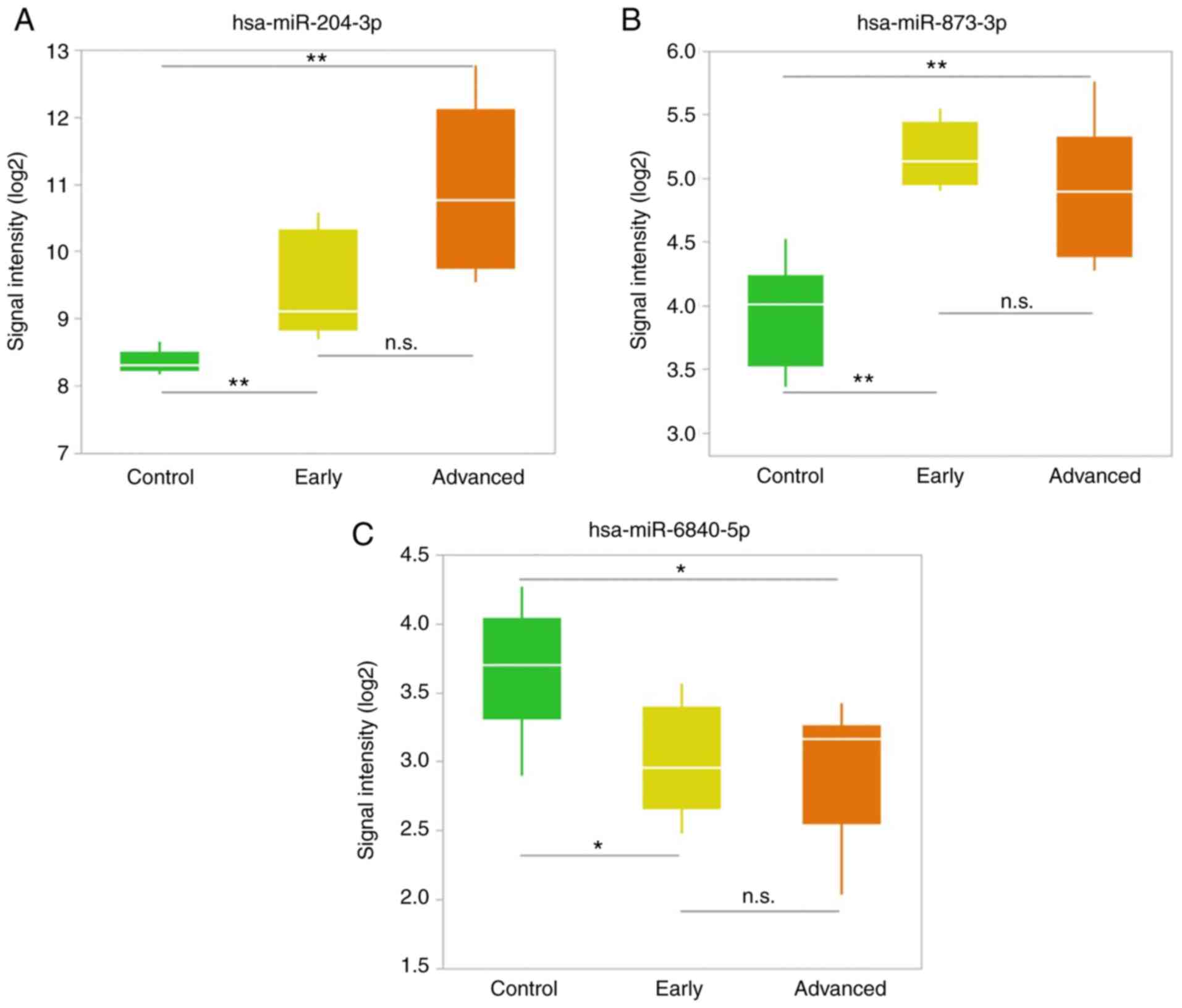|
1
|
Agrawal M and Biswas A: Molecular
diagnostics of neurodegenerative disorders. Front Mol Biosci.
2:542015. View Article : Google Scholar : PubMed/NCBI
|
|
2
|
Lee RC, Feinbaum RL and Ambrost V: The C.
elegans heterochronic gene lin-4 encodes small RNAs with antisense
complementarity to lin-14. Cell. 75:843–854. 1993. View Article : Google Scholar : PubMed/NCBI
|
|
3
|
Quinn JF, Patel T, Wong D, Das S, Freedman
JE, Laurant LC, Carter BS, Hochberg F, van Keuren-Jensen K,
Huentelmann M, et al: Extracellular RNAs: Development as biomarkers
of human disease. J Extracell Vesicles. 4:274952015. View Article : Google Scholar : PubMed/NCBI
|
|
4
|
Rao P, Benito E and Fischer A: MicroRNAs
as biomarkers for CNS disease. Front Mol Neurosci. 6:392013.
View Article : Google Scholar : PubMed/NCBI
|
|
5
|
Roser AE, Caldi Gomes L, Schünemann J,
Maass F and Lingor P: Circulating miRNAs as diagnostic biomarkers
for Parkinson's disease. Front Neurosci. 12:6252018. View Article : Google Scholar : PubMed/NCBI
|
|
6
|
Denk J, Boelmans K, Siegismund C, Lassner
D, Arlt S and Jahn H: MicroRNA profiling of CSF reveals potential
biomarkers to detect Alzheimer's disease. PLoS One.
10:e01264232015. View Article : Google Scholar : PubMed/NCBI
|
|
7
|
Burgos K, Malenica I, Metpally R,
Courtright A, Rakela B, Beach T, Shill H, Adler C, Sabbagh M, Villa
S, et al: Profiles of extracellular miRNA in cerebrospinal fluid
and serum from patients with Alzheimer's and Parkinson's diseases
correlate with disease status and features of pathology. PLoS One.
9:e948392014. View Article : Google Scholar : PubMed/NCBI
|
|
8
|
Steele JC, Richardson JC and Olszewski J:
Progressive Supranuclear palsy: A heterogeneous degeneration
involving the brainstem, basal ganglia and cerebellum with vertical
gaze and pseudobulbar palsy, nuchal dystonia and dementia. Arch
Neurol. 10:333–359. 1964. View Article : Google Scholar : PubMed/NCBI
|
|
9
|
Coyle-Gilchrist IT, Dick KM, Patterson K,
Vázquez Rodríquez P, Wehmann E, Wilcox A, Lansdall CJ, Dawson KE,
Wiggins J, Mead S, et al: Prevalence, characteristics, and survival
of frontotemporal lobar degeneration syndromes. Neurology.
86:1736–1743. 2016. View Article : Google Scholar : PubMed/NCBI
|
|
10
|
Respondek G, Stamelou M, Kurz C, Ferguson
LW, Rajput A, Chiu WC, van Swieten JC, Troakes C, Al Sarraj S,
Glepi E, et al: The phenotypic spectrum of progressive supranuclear
palsy: A retrospective multicenter study of 100 definite cases. Mov
Disord. 29:1758–1766. 2014. View Article : Google Scholar : PubMed/NCBI
|
|
11
|
Magdalinou NK, Paterson RW, Schott JM, Fox
NC, Mummery C, Blennow K, Bhatia K, Morris HR, Giunti P, Warner TT,
et al: A panel of nine cerebrospinal fluid biomarkers may identify
patients with atypical parkinsonian syndromes. J Neurol Neurosurg
Psychiatry. 86:1240–1247. 2015. View Article : Google Scholar : PubMed/NCBI
|
|
12
|
Smith PY, Delay C, Girard J, Papon MA,
Planel E, Sergeant N, Buée L and Hébert SS: MicroRNA-132 loss is
associated with tau exon 10 inclusion in progressive supranuclear
palsy. Hum Mol Genet. 20:4016–4024. 2011. View Article : Google Scholar : PubMed/NCBI
|
|
13
|
Tatura R, Buchholz M, Dickson DW, van
Swieten J, McLean C, Höglinger G and Müller U: MicroRNA profiling:
Increased expression of miR-147a and miR-518e in progressive
supranuclear palsy (PSP). Neurogenetics. 17:165–171. 2016.
View Article : Google Scholar : PubMed/NCBI
|
|
14
|
Höglinger GU, Respondek G, Stamelou M,
Kurz C, Josephs KA, Lang AE, Mollenhauer B, Müller U, Nilsson C,
Whitwell JL, et al: Clinical diagnosis of progressive supranuclear
palsy: The movement disorder society criteria. Mov Disord.
32:853–864. 2017. View Article : Google Scholar : PubMed/NCBI
|
|
15
|
Golbe LI and Ohman-Strickland PA: A
clinical rating scale for progressive supranuclear palsy. Brain.
130:1552–1565. 2007. View Article : Google Scholar : PubMed/NCBI
|
|
16
|
Folstein MF, Folstein SE and McHugh PR:
‘Mini-mental state’: A practical method for grading the cognitive
state of patients for the clinician. J Psychiatr Res. 12:189–198.
1975. View Article : Google Scholar : PubMed/NCBI
|
|
17
|
Dubois B, Slachevsky A, Litvan I and
Pillon B: The FAB: A Frontal assessment battery at bedside.
Neurology. 55:1621–1626. 2000. View Article : Google Scholar : PubMed/NCBI
|
|
18
|
Nasreddine ZS, Phillips NA, Bédirian V,
Charbonneau S, Whitehead V, Collin I, Cummings JL and Chertkow H:
The montreal cognitive assessment, MoCA: A brief screening tool for
mild cognitive impairment. J Am Geriatr Soc. 53:695–699. 2005.
View Article : Google Scholar : PubMed/NCBI
|
|
19
|
Quattrone A, Morelli M, Williams DR,
Vescio B, Arabia G, Nigro S, Nicoletti G, Salsone M, Novellino F,
Nisticò R, et al: MR parkinsonism index predicts vertical
supranuclear gaze palsy in patients with PSP-parkinsonism.
Neurology. 87:1266–1273. 2016. View Article : Google Scholar : PubMed/NCBI
|
|
20
|
Quattrone A, Morelli M, Nigro S, Quattrone
A, Vescio B, Arabia G, Nicoletti G, Nisticò R, Salsone M, Novellino
F, et al: A new MR imaging index for differentiation of progressive
supranuclear palsy-parkinsonism from Parkinson's disease.
Parkinsonism Relat Disord. 54:3–8. 2018. View Article : Google Scholar : PubMed/NCBI
|
|
21
|
Edgar R, Domrachev M and Lash AE: Gene
expression omnibus: NCBI gene expression and hybridization array
data repository. Nucleic Acids Res. 30:207–210. 2002. View Article : Google Scholar : PubMed/NCBI
|
|
22
|
Conte I, Hadfield KD, Barbato S, Pizzo M,
Bhat RS, Carissimo A, Karali M, Porter LF, Urquhart J, Hateley S,
et al: miR-204 is responsible for inherited retinal dystrophy
associated with ocular coloboma. Proc Natl Acad Sci USA.
112:E3236–E3245. 2015. View Article : Google Scholar : PubMed/NCBI
|
|
23
|
Gattolliat CH, Thomas L, Ciafrè SA,
Meurice G, Le Teuff G, Job B, Richon C, Combaret V, Dessen P,
Valteau-Couanet D, et al: Expression of miR-487b and miR-410
encoded by 14q32.31 locus is a prognostic marker in neuroblastoma.
Br J Cancer. 105:1352–1361. 2011. View Article : Google Scholar : PubMed/NCBI
|
|
24
|
Liu X, He F, Pang R, Zhao D, Qiu W, Shan
K, Zhang J, Lu Y, Li Y and Wang Y: Interleukin-17 (IL-17)-induced
MicroRNA 873 (miR-873) contributes to the pathogenesis of
experimental autoimmune encephalomyelitis by targeting A20
Ubiquitin-editing enzyme. J Biol Chem. 289:28971–28986. 2014.
View Article : Google Scholar : PubMed/NCBI
|
|
25
|
Eiring AM, Harb JG, Neviani P, Garton C,
Oaks JJ, Spizzo R, Liu S, Schwind S, Santhanam R, Hickey CJ, et al:
miR-328 Functions as an RNA decoy to modulate hnRNP E2 Regulation
of mRNA translation in leukemic blasts NIH Public Access. Cell.
140:652–665. 2010. View Article : Google Scholar : PubMed/NCBI
|
|
26
|
Schneider R, McKeever P, Kim TH, Graff C,
van Swieten JC, Karydas A, Boxer A, Rosen H, Miller BL, Laforce R
Jr, et al: Downregulation of exosomal miR-204-5p and miR-632 as a
biomarker for FTD: A GENFI study. J Neurol Neurosurg Psychiatry.
89:851–858. 2018. View Article : Google Scholar : PubMed/NCBI
|
|
27
|
Starhof C, Hejl AM, Heegaard NHH, Carlsen
AL, Burton M, Lilje B and Winge K: The biomarker potential of
cell-free microRNA from cerebrospinal fluid in Parkinsonian
syndromes. Mov Disord. 34:246–254. 2019. View Article : Google Scholar : PubMed/NCBI
|
|
28
|
Song S, Fajol A, Tu X, Ren B and Shi S:
miR-204 suppresses the development and progression of human
glioblastoma by targeting ATF2. Oncotarget. 7:70058–70065. 2016.
View Article : Google Scholar : PubMed/NCBI
|
|
29
|
Banaei-Esfahani A, Moazzeni H, Nosar PN,
Amin S, Arefian E, Soleimani M, Yazdani S and Elahi E: MicroRNAs
that target RGS5. Iran J Basic Med Sci. 18:108–114. 2015.PubMed/NCBI
|
|
30
|
Pan BF, Gao C, Ren SX, Wang YB, Sun HP and
Zhou MY: Regulation of PP2Cm expression by miRNA-204/211 and
miRNA-22 in mouse and human cells. Acta Pharmacol Sin.
36:1480–1486. 2015. View Article : Google Scholar : PubMed/NCBI
|
|
31
|
Wang L, Tian H, Yuan J, Wu H, Wu J and Zhu
X: CONSORT: Sam68 is directly regulated by miR-204 and promotes the
self-renewal potential of breast cancer cells by activating the
wnt/beta-catenin signaling pathway. Medicine (Baltimore).
94:e22282015. View Article : Google Scholar : PubMed/NCBI
|
|
32
|
Yang Y and Liang C: MicroRNAs: An emerging
player in autophagy. ScienceOpen Res. Dec 22–2015.(Epub ahead of
print). doi: 10.14293/S2199-1006.1.SOR-LIFE.A181CU.v1. PubMed/NCBI
|
|
33
|
Zhang S, Gao L, Thakur A, Shi P, Liu F,
Feng J, Wang T, Liang Y, Liu JJ, Chen M and Ren H: MiRNA-204
suppresses human non-small cell lung cancer by targeting ATF2.
Tumor Biol. 37:11177–11186. 2016. View Article : Google Scholar : PubMed/NCBI
|
|
34
|
Li N, Guo X, Liu L, Wang L and Cheng R:
Molecular mechanism of miR-204 regulates proliferation, apoptosis
and autophagy of cervical cancer cells by targeting ATF2. Artif
Cells, Nanomed Biotechnol. 47:2529–2535. 2019. View Article : Google Scholar : PubMed/NCBI
|
|
35
|
Katsuragi Y, Ichimura Y and Komatsu M:
P62/SQSTM1 functions as a signaling hub and an autophagy adaptor.
FEBS J. 282:4672–4678. 2015. View Article : Google Scholar : PubMed/NCBI
|
|
36
|
Chi SW, Zang JB, Mele A and Darnell RB:
Argonaute HITS-CLIP decodes microRNA-mRNA interaction maps. Nature.
460:479–486. 2009. View Article : Google Scholar : PubMed/NCBI
|
|
37
|
Weber A, Schwarz SC, Tost J, Trümbach D,
Winter P, Busato F, Tacik P, Windhorst AC, Fagny M, Arzberger T, et
al: Epigenome-wide DNA methylation profiling in progressive
supranuclear palsy reveals major changes at DLX1. Nat Commun.
9:29292018. View Article : Google Scholar : PubMed/NCBI
|
|
38
|
Hafner M, Landthaler M, Burger L, Khorshid
M, Hausser J, Berninger P, Rothballer A, Ascano M Jr, Jungkamp AC,
Munschauer M, et al: Transcriptome-wide identification of
RNA-binding protein and microRNA target sites by PAR-CLIP. Cell.
141:129–141. 2010. View Article : Google Scholar : PubMed/NCBI
|
|
39
|
Xue Y, Ouyang K, Huang J, Zhou Y, Ouyang
H, Li H, Wang G, Wu Q, Wei C, Bi Y, et al: Direct conversion of
fibroblasts to neurons by reprogramming PTB-regulated microRNA
circuits. Cell. 152:82–96. 2013. View Article : Google Scholar : PubMed/NCBI
|
|
40
|
Krell J, Stebbing J, Carissimi C,
Dabrowska AF, de Giorgio A, Frampton AE, Harding V, Fulci V, Macino
G, Colombo T and Castellano L: TP53 regulates miRNA association
with AGO2 to remodel the miRNA-mRNA interaction network. Genome
Res. 26:331–341. 2016. View Article : Google Scholar : PubMed/NCBI
|
|
41
|
Obara Y, Sato H, Nakayama T, Kato T and
Ishii K: Midnolin is a confirmed genetic risk factor for
Parkinson's disease. Ann Clin Transl Neurol. 6:2205–2211. 2019.
View Article : Google Scholar : PubMed/NCBI
|
|
42
|
Obara Y, Imai T, Sato H, Takeda Y, Kato T
and Ishii K: Midnolin is a novel regulator of parkin expression and
is associated with Parkinson's disease. Sci Rep. 7:58852017.
View Article : Google Scholar : PubMed/NCBI
|
|
43
|
Karginov FV and Hannon GJ: Remodeling of
Ago2-mRNA interactions upon cellular stress reflects miRNA
complementarity and correlates with altered translation rates.
Genes Dev. 27:1624–1632. 2013. View Article : Google Scholar : PubMed/NCBI
|
|
44
|
Spengler RM, Zhang X, Cheng C, McLendon
JM, Skeie JM, Johnson FL, Davidson BL and Boudreau RL: Elucidation
of transcriptome-wide microRNA binding sites in human cardiac
tissues by Ago2 HITS-CLIP. Nucleic Acids Res. 44:7120–7131.
2016.PubMed/NCBI
|
|
45
|
Ding X, Barodia SK, Ma L and Goldberg MS:
Fbxl18 targets LRRK2 for proteasomal degradation and attenuates
cell toxicity. Neurobiol Dis. 98:122–136. 2017. View Article : Google Scholar : PubMed/NCBI
|
|
46
|
Upadhyay A, Amanullah A, Chhangani D,
Mishra R, Prasad A and Mishra A: Mahogunin ring finger-1 (MGRN1), a
multifaceted ubiquitin ligase: Recent unraveling of neurobiological
mechanisms. Mol Neurobiol. 53:4484–4496. 2016. View Article : Google Scholar : PubMed/NCBI
|
|
47
|
Ramaswamy P, Christopher R, Pal PK and
Yadav R: MicroRNAs to differentiate Parkinsonian disorders:
Advances in biomarkers and therapeutics. J Neurol Sci. 394:26–37.
2018. View Article : Google Scholar : PubMed/NCBI
|

















